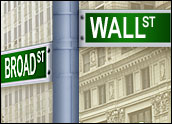
Michael Lewis did not do the securities industry any favors, at least in the short term, with the publication of his new book, Flash Boys: A Wall Street Revolt. His portrayal of how investment banks use high-frequency trading to leverage the few additional milliseconds this technology provides to grab stocks at optimal prices appears to have been a factor behind federal agency decisions to investigate this activity.
The issue has been on the Securities and Exchange Commission’s radar for some time; news surfaced last week that the Federal Bureau of Investigation also was on the case; and Attorney General Eric Holder on Friday told a congressional hearing the Justice Department would conduct a probe of its own.
Letter vs. Spirit of Law
As these investigations unfold, it will become increasingly clear that there are no simple answers to the question of whether this technology — actually a mix of technologies including extremely fast telecom connections, microwave towers and special access to exchanges — is allowing some traders to take an unfair advantage in the marketplace.
At first blush, it appears they are violating the spirit of laws against insider trading, or securities fraud, by using information available only to a few. However, they are obtaining this information not with the intent to defraud but rather with the goal of making a profit, which according to some legal analyses is not against the letter of the law.
Complicating matters further is a Reuters analysis about how the growing amount of trading outside normal exchanges is the real danger to investors and market stability. The growing use of so-called “dark pools” and other means of off-exchange trading is far more worrisome than the use of speedy technology to outmaneuver the market, it concludes.
Given the ambiguity of the situation, to say nothing of its many complicated nuances, it could well come down to this: Technology once again has outpaced the law.
‘Nothing Inherently Wrong’
“Technology moves at warp speed, and regulators and the law move far more slowly. high-frequency trading is clearly a case of technology moving far faster than the law,” Tres Arnett, a financial services litigation partner at McCarter & English, told the E-Commerce Times. His take: “There’s nothing inherently wrong with high-frequency trading.”
What is clearly illegal, he said, is traders employing technology for nefarious purposes — that is, using it to create false appearances in the market, or engaging in riskless arbitrage by locating their software and hardware next to the exchanges’ own data centers, giving them an advantage over the public.
Another IT problem area, which is not necessarily fraud-related, is software bugs, but Arnett noted that regulators in the last few years have focused on that and eliminated many of the issues.
“The fundamental collision of law and technology for securities investors is that high frequency traders trade in nanoseconds, but the regulators measure fairness in milliseconds,” explained Arnett.
Technology also muddies the water with dark pools, making this activity seem suspect as well. Nevertheless, this too is fundamentally a legal activity, according to Arnett.
With the dark pools, “the concern is a lack of transparency in how orders are matched within the dark pool. Again, there is nothing wrong with matching buyers and sellers within your own venue before sending an order to a different market — but when nobody knows exactly how and when orders are matched, people fear they’re being taken advantage of.”
The name “dark pool” doesn’t help, he added.
Regulators’ Tech Challenge
High-frequency trading is on the right side of the law, said Walter Ferstand, capital markets compliance expert at NICE Actimize, but U.S. regulatory authorities need to step up their own tech sophistication to stay on top of market developments.
“What high frequency traders are doing is not technically illegal,” he told the E-Commerce Times, but “the SEC’s enforcers aren’t equipped to monitor market manipulation at the speeds at which high-frequency traders operate.”
The SEC does seem to recognize this, he added.
“Under Mary Jo White’s leadership, the SEC is taking steps to examine high-frequency trading, educate its field examiners, and hire from the very industries that the SEC is monitoring. They are moving in the right direction to try to match the sophistication of the high-frequency trading firms,” Ferstand said.
“You need technology to police the markets effectively,” he concluded, as dark markets and high-frequency trading become more prevalent.






















































Social Media
See all Social Media